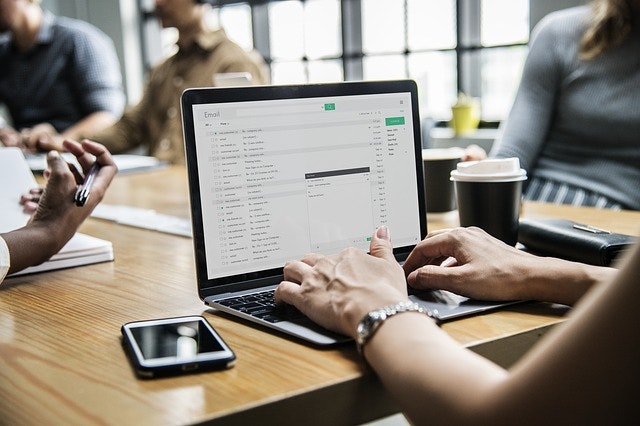How to End an Email: The Best Ways to Sign Off
All products and services featured are independently selected by WikiJob. When you register or purchase through links on this page, we may earn a commission.
There is nothing worse than saying the wrong thing to the wrong person.
Like when a waiter says, “Enjoy your meal” and you reply with, “You too.”
Or when you call your boss “Dad” – especially if your boss is a woman.
That’s why it's important to find the right way to sign off an email: you want to create the right impression with that individual.

First Things First: Remember the Basics
There are some things every email sign-off should include:
- A closing remark – This is often the hardest part of your sign-off to get right and can be as plain as ‘Thanks’ or as formal as ‘Kind regards’. It's best to avoid very formal options, which are more appropriate in a letter than an email.
- Your name – How you write your name will depend on who you are emailing. If it's informal, just use your first name. For more professional contexts, go with your first and last name.
- Contact details – Yes, even today some people would rather speak on the phone than type a reply to your email. It is polite to at least give them the option.
- Job and company information – You will often be emailing people who do not know you, and even those who have met you might have forgotten exactly what position you hold at your company. Including this information helps ensure that the person you are emailing understands who you are and the context of your message.
- Disclaimer – Many organizations insist on you placing a disclaimer at the end of your emails. Often, the company email system adds this disclaimer automatically but, if not, make sure you include any required statements.
Aside from these key elements, crafting the ideal end to an email becomes less of a science and more of an art.
How Not to Do It
It is sometimes simpler to list ways not to do something. Here are ten things that you definitely want to avoid when signing off an email:
-
Love – Unless it’s your mum, or you have a very odd relationship with your boss, do not use this for professional emails. Also, even one kiss is too many; seriously, no kisses.
-
Thx or Rgrds – You are not a teenager anymore. If you are still signing emails like this, stop it.
-
Take care – Is the recipient in mortal danger? Unless they are, this is a firm no.
-
Hoping to hear from you soon – The king of passive-aggressive sign-offs, this is just a polite way of saying "you'd better reply to my email quickly." Don't be one those people.
-
Have a blessed day – Only if you are an archbishop.
-
Respectfully yours – For those times when you are emailing the President or the Queen of England. Otherwise, a little formal for everyday use.
-
Yours truly – Do you belong to the person you are writing to? If not, this just sounds bogus.
-
Cheers – Unless you are the owner of a bar, or are sending an email planning some drinks after work, this is best avoided.
-
–Joe, or –J – This looks as though you were too lazy to write a proper sign-off. Or that you've forgotten how to spell your name. Either way, not a wise choice except for the very shortest and most informal emails to close colleagues.
-
Sent from my iPhone – Its one virtue is that this signature serves as a catch-all ‘sorry for all the typos, I have fat thumbs,’ excuse. Unfortunately, it also says you were too idle to create a proper signature.
Classic Sign-Offs, and When They Work Best
Old doesn't always equal best, but if you often find yourself wondering how to end a professional email, sticking to a traditional sign-off can be the safest option. These have stood the test of time and are still often the best way to close off an email:
- Sincerely – For formal correspondence, such as a covering letter or a professional email, ‘sincerely’ shows the right amount of respect. Remember, though, that for less formal emails this will come across as a little staid.
- Best wishes – To be used with care and only when it fits with the tone of your email. Usually a safe bet.
- Regards, or Kind regards – Stale and stodgy it may be, but that is also why it works. If you need a way to end a semi-formal, everyday email this is probably the most unremarkable way to do it.
- Thanks – Another informal sign-off; only use ‘thanks’ when you actually want to say thank you for something. When overused at the end of every email it becomes devalued, making it harder for you to thank someone when you really need to.
- Best – If you receive a lot of emails you will know just how common it is to see messages signed off this way. This commonality makes it an acceptable choice; like ‘Regards’ but less formal. Remember, though, that the very omnipresence of ‘Best’ can make it seem dull and unimaginative.
- As ever, or As always – This is one for people who you know well and email regularly. It says that everything between you is as good now as it has ever been which, hopefully, is a good thing.
- Thanks in advance – Use with care, as it can risk sounding almost as passive-aggressive as ‘Hoping to hear from you soon’. A wise option is to keep ‘Thanks in advance’ to occasions when you are certain there is no chance it will be misinterpreted.
- I appreciate your help/response/input/feedback etc. – Thanking someone for their work is always a good thing.
Using Humour and Creativity
Injecting a little humour into an email can help brighten the recipient’s day. Care is vital, though, as misjudged humour can easily offend or cause upset.
If you are new to sending business emails, or if you are unsure whether you are striking the right tone, it's best to keep humour to family, friends and close colleagues.
Signing Off Your Emails in Different Situations
You wouldn't end a phone call with your best friend the same way as with your managing director. Emails are no different. Considering the recipient and the nature of the email is important when choosing the right sign-off. Here are a few examples of how to end certain types of business email:
When You Are Requesting a Meeting
Sign-offs are an ideal place for a call to action, and to remind the person you are writing to what it is you want from them. That way, even if they fail to take in the rest of the email, the last line is a clear reminder of what you need.
Examples include:
- ‘Happy to work around your availability to find a meeting slot'
- ‘Hoping for a gap in your schedule’
When You're Sending an Update or Answering a Request
This is one example of when not to sign off with ‘Thanks’. You are doing something for the recipient, not the other way around.
Instead, consider something along the lines of:
- ‘That's all I've got for now, let me know if you need any more information’
- ‘Happy to help with any questions’
When You're Looking for Information or Feedback
If people feel valued then they are more likely to be open to helping you out. Be clear about what you need but come across as considerate rather than demanding. Possible strategies include:
- ‘Thanks in advance for your time’
- ‘Looking forward to hearing your thoughts’
- ‘I appreciate your help with this’
Should You Automate Your Sign-Off?
If you are a busy person you might receive tens or even hundreds of emails a day. One way to streamline your email workflow is to include a pre-written sign-off in your email signature. Automating your email signature like this, though, has disadvantages as well as gains:
Advantages
Disadvantages
Speeds up the process of sending and replying to emails. Not only do you not have to write a sign-off for each email, but it also saves the time you’d take deciding what the right approach for each email should be.
Emails appear less personal.
Using an uncomplicated sign-off means there is no risk of misplaced humour causing upset or offence.
A ‘one-size fits all’ approach rarely fits any one situation perfectly; so you may spend as much time adapting your automated signature as you thought you would save.
It ensures that you never miss out any vital information (e.g. your contact details or company disclaimers).
Can reduce the email response rate by removing the opportunity to include a tailored call to action.
Reduces the risk of typos, spelling mistakes or other errors.
Often causes formatting problems if you mix HTML and plain text emails.
Final Thoughts
Emails are a very personal form of communication. Considering the person you are contacting, before pressing the send button, will help you get what you are looking for from your email.
Choosing the right email sign-off is part of that consideration, but only part of it. Just as different painters have their own style with a brush, so we all have our own personal style when writing emails.
Remembering the key rules in this article should prevent you from going too far wrong. But it is also important to develop your own voice. Perhaps try rephrasing some of the examples. Or even, for less formal emails, injecting a small amount of carefully considered humour.
That said, if you are ever in any doubt as to how your email will be received, more formal is always the safer option.






